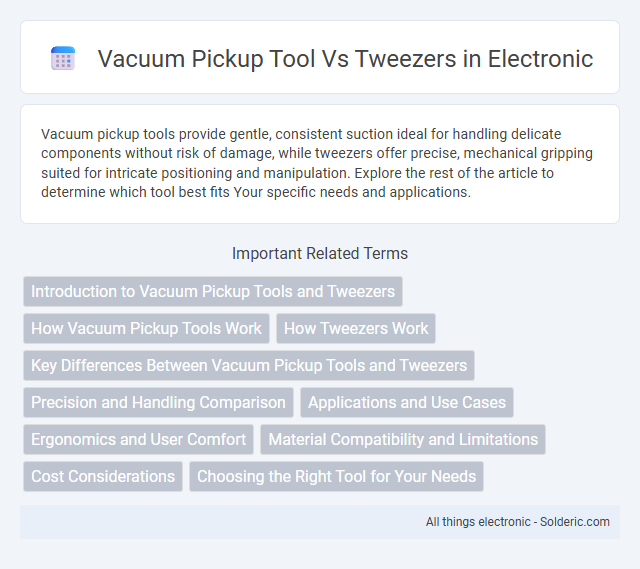Vacuum pickup tools provide gentle, consistent suction ideal for handling delicate components without risk of damage, while tweezers offer precise, mechanical gripping suited for intricate positioning and manipulation. Explore the rest of the article to determine which tool best fits Your specific needs and applications.
Comparison Table
| Feature | Vacuum Pickup Tool | Tweezers |
|---|---|---|
| Usage | Picking up small electronic components and delicate parts | Grasping and manipulating small objects manually |
| Precision | High precision via suction, reduces damage risk | High precision with manual control |
| Contact Type | Non-contact, suction-based | Direct contact with tips |
| Suitable Materials | Flat, non-porous surfaces | Varied surfaces, including delicate items |
| Risk of Damage | Low due to gentle suction | Moderate, depends on user skill |
| Ease of Use | Requires setup and power source | Simple and portable |
| Applications | Electronics assembly, laboratory work | Jewelry making, electronics, crafts |
| Cost | Generally higher due to technology | Typically lower and affordable |
Introduction to Vacuum Pickup Tools and Tweezers
Vacuum pickup tools use suction to grasp and move delicate electronic components without direct contact, reducing the risk of damage or contamination. Tweezers rely on manual gripping, providing precise control but increasing the chance of applying uneven pressure or causing electrostatic discharge. In electronics assembly, vacuum pickup tools offer a safer and more efficient alternative to traditional tweezers for handling sensitive parts.
How Vacuum Pickup Tools Work
Vacuum pickup tools operate by creating negative pressure to securely lift and hold small components, making them ideal for delicate electronic parts and fragile materials where precision is crucial. These tools use a suction mechanism, often powered by compressed air or an electric vacuum pump, to generate a controlled vacuum that prevents damage during handling. Unlike tweezers, vacuum pickup tools minimize the risk of physical force or contamination, improving efficiency in automated assembly and inspection processes.
How Tweezers Work
Tweezers operate by applying precise pressure with two elongated arms to grasp and manipulate small objects through mechanical force, offering fine control especially for delicate electronics or laboratory tasks. Unlike vacuum pickup tools that use suction to lift components, tweezers rely on direct contact and finger coordination for accuracy. Their design allows for easy handling of tiny parts without risk of contaminating surfaces with adhesive residue or air flow.
Key Differences Between Vacuum Pickup Tools and Tweezers
Vacuum pickup tools utilize suction to securely lift and place small components without direct contact, minimizing the risk of damage or contamination, while tweezers rely on mechanical grip and manual dexterity to handle objects. Vacuum pickups excel in handling delicate or irregularly shaped items in automated environments, whereas tweezers offer precision control suited for manual tasks and quick adjustments. The primary difference lies in contact method and application: vacuum tools provide non-contact handling ideal for cleanroom and electronic assembly, while tweezers deliver tactile feedback essential for intricate manual work.
Precision and Handling Comparison
Vacuum pickup tools offer enhanced precision for handling small, delicate electronic components without direct contact, reducing the risk of damage or contamination. Tweezers provide fine manual control and tactile feedback, making them ideal for tasks requiring careful manipulation of tiny parts in tight spaces. Your choice between these tools should consider the specific precision and handling needs of your assembly or repair work.
Applications and Use Cases
Vacuum pickup tools excel in handling delicate electronic components, small lenses, and static-sensitive parts, making them ideal for precision assembly and manufacturing environments. Tweezers are commonly used for general tasks requiring manual control, such as picking up small objects, crafting, or medical procedures where tactile feedback is essential. Your choice depends on the need for automation, precision, and the sensitivity of the materials involved.
Ergonomics and User Comfort
Vacuum pickup tools offer superior ergonomics by reducing hand strain through lightweight, balanced designs and cushioned grips, making them ideal for prolonged use compared to tweezers. Tweezers often require precise finger pressure, which can lead to fatigue and discomfort over time, especially during detailed tasks. Your choice should prioritize tools that maintain comfort and minimize repetitive stress to enhance productivity and reduce the risk of hand injuries.
Material Compatibility and Limitations
Vacuum pickup tools excel in handling delicate semiconductor components like silicon chips and glass substrates, minimizing mechanical stress and contamination risks. Tweezers, typically made from stainless steel or antistatic plastic, offer precise control but can damage sensitive materials due to direct contact and pressure applied. Material compatibility of vacuum tools favors non-porous, flat surfaces, while tweezers accommodate a broader range of shapes but risk scratching or bending fragile parts.
Cost Considerations
Vacuum pickup tools typically have higher upfront costs due to their complex design and electronic components, making them a more significant investment for precision handling. Tweezers, by contrast, are generally low-cost, manual tools that offer affordability and simplicity for basic tasks but may lack the finesse required for delicate or high-volume operations. Budget-conscious users often weigh the initial expense of vacuum tools against the durability and repeated use benefits provided by tweezers in cost-sensitive environments.
Choosing the Right Tool for Your Needs
Vacuum pickup tools provide precise, damage-free handling of small electronic components, ideal for delicate tasks requiring steady suction and minimal contact. Tweezers offer greater control and versatility for a wide range of materials but may cause damage if excessive pressure is applied. Assess the fragility of the components and the required precision to select the best tool for your specific application.
vacuum pickup tool vs tweezers Infographic

 solderic.com
solderic.com